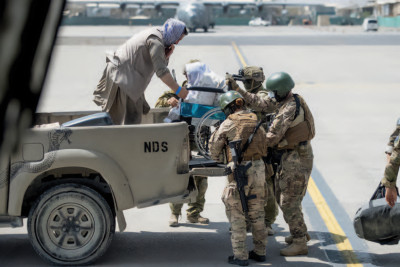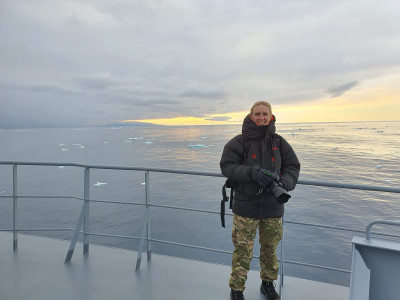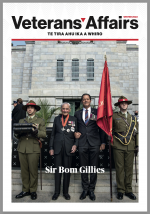20 minutes on the runway at Kabul Airport: NZDF Photographer Maria Eves
20 minutes on the runway at Kabul Airport: NZDF Photographer Maria Eves
Just 20 minutes on the runway at Kabul airport, but in those moments Maria Eves brought all of her 12 years of experience as a photographer in the NZDF to bear.
Maria Eves joined the Royal New Zealand Air Force as a photographer (Aircraftman) in 2009. Based at Whenuapai, for 13 years Maria photographed many Defence Force activities, including commemorations (Gallipoli, Crete 75th, Somme 100th), Army training exercises, Navy divers in action, mountain flying in an NH90 helicopter and tactical flights in a C-130 Hercules.
Promoted to Sergeant and to Lead Photographer, Maria was responsible for a team of eight other NZDF photographers. She recently left the RNZAF, but of her thirteen years in service, her last 6 months might have been her most memorable.
In August 2021, Maria left for Dubai on her way to cover the evacuation of Afghanistan. On that flight her nerves kicked in.
“Leaving is easy, but once on that flight I realised that I really didn’t know what I was going to face, how dangerous it might be or anything about what it was going to look like.”
She landed in Dubai several days before the C-130 Hercules that was scheduled for the evacuation arrived. Her apprehension lessened as she prepared for the evacuation although it did include rifle training as she would be carrying a rifle to Kabul.
She caught up with a photographer from the Australian Defence Force who reassured her that the US forces had secured the Kabul airport well. When the Hercules arrived Maria was confident about her assignment, but the flight to Kabul was far from certain.
“It was completely dependent on what the US forces were planning to do. We didn’t know exactly when they were going to leave, and whether we could get in.”
But they were able to fly to Kabul and Kabul airport wasn’t as she had expected.
“It was very hot, but very ordered. Everything was organised — exceptionally well organised. It was nothing like what I had seen in the media. No swarming crowds, no yelling, and I couldn’t hear any gunfire.”
Maria took up a position on the flightline just by the Hercules’ loading ramp. The evacuees were in line and ready to go. The first was an elderly lady in a wheelchair, and she became the subject of one of Maria’s most well-recognised photos.
“She was being lifted off the back of a ute. It was a moment that captured so much about what we were doing in Afghanistan.”

Maria Eves captured poent moments in the humanitarian efforts at Kabul Airport
“The evacuees included young children, and there were a lot of babies. All families of the people who had helped the New Zealand forces while they were in Afghanistan.”
The evacuation went without a hitch, and they were soon in the air again.
“In just 20 minutes we had everyone on board and we were heading back to Dubai.”
Maria was very impressed with the organisation and compassion of the kiwi service people at Kabul airport, but then had more reason to be proud of NZDF staff when they landed.
“In Dubai many NZDF staff came down to the airport to help the evacuees transfer to a civilian flight to New Zealand. They helped with ticketing, entertaining the kids, making sure everyone had something to eat — it was wonderful to see.”
“The evacuation was NZDF’s humanitarian role performed at its best.”
Soon after arriving home (4 months), Maria boarded HMNZS Aotearoa to resupply McMurdo Station in Antarctica. However, an undersea volcano called Hunga Tonga-Hunga Ha’apai, erupted and triggered a tsunami that swept through homes on Tonga’s nearby islands.
The Aotearoa and Maria sailed to Tonga to deliver emergency supplies such as milk powder, tarpaulins and 415,000 litres of freshwater. COVID-19 restrictions kept the crew aboard.
“I could only take photos from the ship. The devastation was clear to see. The Parliament buildings which are usually a pristine white with a red roof were covered in brown ash, as was the rest of Nuku’alofa.”
However, she took photos of the on-board activities and was able to get some shots of the ash-covered roofs in the city, containers being unloaded and the Aotearoa refuelling a number of ships from other nations. On two occasions the HMNZS Aotearoa performed a replenishment at sea (RAS).
They returned to New Zealand, and without landing, due to covid protocols, they resupplied and set off for Antarctica.

Maria Eves in Antarctica
“You know you are there long before you arrived, the massive icebergs tell you so.” “We sailed through the pack ice. It was other-worldly. Although the continent itself wasn’t as white as I thought that it was going to be.”
“We were able to land and we explored the Hillary Hut, but we weren’t allowed to interact with staff at Scott Base.”
The Antarctic assignment was an appropriate end to Maria’s NZDF career. Her photographic interest lies in landscape photography and now that she has left NZDF she is building her online landscape photography business.
“It is my passion, one that I put into the background as I developed my skills and worked for the NZDF, but now very happy to be back to it and being able to pursue it while being close to my family.”
Maria is only a few weeks out of the NZDF, but is there anything that she misses?
“NZDF people are wonderful. I met so many in so many different places — on bases, ships and planes — and every now and again I would bump into them again and it was like meeting a family member. Yes, I miss the NZDF family.”
Maria Eves’ landscape photography can be found at www.mariaevesphotography.com(external link)
You can read more stories and updates in the Winter 2022 edition of the Veterans' Affairs Magazine
